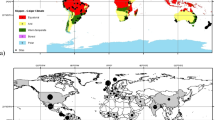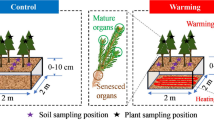Abstract
Increases in the concentration of atmospheric carbon dioxide may have a fertilizing effect on plant growth by increasing photosynthetic rates and therefore may offset potential growth decreases caused by the stress associated with higher temperatures and lower precipitation. However, plant growth is determined both by rates of net photosynthesis and by proportional allocation of fixed carbon to autotrophic tissue and heterotrophic tissue. Although CO2 fertilization may enhance growth by increasing leaf-level assimilation rates, reallocation of biomass from leaves to stems and roots in response to higher concentrations of CO2 and higher temperatures may reduce whole-plant assimilation and offset photosynthetic gains. We measured growth parameters, photosynthesis, respiration, and biomass allocation of Pinus ponderosa seedlings grown for 2 months in 2×2 factorial treatments of 350 or 650μ bar CO2 and 10/25° C or 15/30° C night/day temperatures. After 1 month in treatment conditions, total seedling biomass was higher in elevated CO2, and temperature significantly enhanced the positive CO2 effect. However, after 2 months the effect of CO2 on total biomass decreased and relative growth rates did not differ among CO2 and temperature treatments over the 2-month growth period even though photosynthetic rates increased ≈7% in high CO2 treatments and decreased ≈10% in high temperature treatments. Additionally, CO2 enhancement decreased root respiration and high temperatures increased shoot respiration. Based on CO2 exchange rates, CO2 fertilization should have increased relative growth rates (RGR) and high temperatures should have decreased RGR. Higher photosynthetic rates caused by CO2 fertilization appear to have been mitigated during the second month of exposure to treatment conditions by a ≈3% decrease in allocation of biomass to leaves and a ≈9% increase in root:shoot ratio. It was not clear why diminished photosynthetic rates and increased respiration rates at high temperatures did not result in lower RGR. Significant diametrical and potentially compensatory responses of CO2 exchange and biomass allocation and the lack of differences in RGR of ponderosa pine after 2 months of exposure of high CO2 indicate that the effects of CO2 fertilization and temperature on whole-plant growth are determined by complex shifts in biomass allocation and gas exchange that may, for some species, maintain constant growth rates as climate and atmospheric CO2 concentrations change. These complex responses must be considered together to predict plant growth reactions to global atmospheric change, and the potential of forest ecosystems to sequester larger amounts of carbon in the future.
Similar content being viewed by others
References
Acock B, Allen LH Jr (1985) Crop responses to elevated carbon dioxide concentrations. In: Strain BR, Cure JD (eds) Direct effects of increasing carbon dioxide concentration on vegetation (DOE/ER-0238). US Department of Energy, Washington DC, pp 53–97
Agren GI, Ingestad T (1987) Root:shoot ratio as balance between nitrogen productivity and photosynthesis. Plant Cell Environ 10: 573–586
Billings WD (1950) Vegetation and plant growth as affected by chemically altered rocks in the Great Basin. Ecology 31: 62–74
Brown K, Higginbotham KO (1986) Effects of carbon dioxide enrichment and nitrogen supply on growth of boreal tree seedlings. Tree Physiol 2: 223–232
Bunce JA (1990) Short- and long-term inhibition of respiratory carbon dioxide efflux by elevated carbon dioxide. Ann Bot 65: 637–642
Callaway RM, DeLucia EH, Schlesinger WH (1994) Aboveground biomass allocation ponderosa pine along an elevational gradient: an analog for response to climate change. Ecology (in press)
Cure JD, Acock B (1986) Crop responses to CO2 doubling: a literature survey. Agric For Meteorol 38: 127–145
DeLucia EH, Schlesinger WH (1991) Resource-use efficiency and drought tolerance in adjacent Great Basin and Sierran plants. Ecology 72: 51–58
DeLucia EH, Smith WK (1987) Air and soil temperature limitations on photosynthesis in Englemann spruce during summer. Can J For Res 17: 527–533
DeLucia EH, Schlesinger WH, Billings WD (1988) Water relations and the maintenance of Sierran conifers on hydrothermally altered rock. Ecology 69: 303–311
Eamus D (1991) The interaction of rising CO2 and temperatures with water use efficiency. Plant Cell Environ 14: 843–852
Eamus D, Jarvis PG (1989) The direct effects of increase in the global atmospheric CO2 concentration on natural and commercial temperate trees and forests. Adv Ecol Res 19: 1–55
Evans GC (1972) The quantitative analysis of plant growth. Blackwell Scientific, Oxford
Farrar JF, Williams ML (1991) The effects of increased atmospheric carbon dioxide and temperature on carbon partitioning, source-sink relations and respiration. Plant Cell Environ 14: 819–830
Gholz HL (1982) Environmental limits on aboveground net primary production, leaf area, and biomass in vegetation zones of the Pacific Northwest. Ecology 63: 469–481
Graumlich LJ (1991) Subalpine tree growth, climate and increasing CO2: an assessment of recent growth trends. Ecology 72: 1–11
Graybill DA (1987) A network of high elevation conifers in the western US for detection of tree-ring growth response to increasing atmospheric carbon dioxide. In: Jacoby GC, Hornbeck JW (eds) Proceedings of the international symposium on ecological aspects of tree-ring analysis (Conference Report DOE/CONF-8608144). United States Department of Energy Washington DC, pp 463–474
Graybill DA, Idso SB (1993) Detecting the aerial fertilization effect of atmospheric CO2 enrichment in tree-ring chronologies. Global Biogeochem Cycles 7: 81–95
Green K, Wright R (1977) Field response of photosynthesis to CO2 enhancement in ponderosa pine. Ecology 58: 687–692
Grier CC, Running SW (1977) Leaf area of mature northwestern coniferous forests: relation to site water balance. Ecology 58: 893–899
Higginbotham KO, Mayo JM, L'Hirondelle S, Krystofiak DK (1985) Physiological ecology of lodgepole pine (Pinus contorta) in an enriched CO2 environment. Can J For Res 15: 417–421
Hollinger DY (1987) Gas exchange and dry matter allocation responses to elevation of atmospheric CO2 concentration in seedlings of three tree species. Tree Physiol 3: 193–202
Idso SB, Kimball BA, Anderson MG, Mauney JR (1987) Effects of atmospheric CO2 enrichment on plant growth: the interactive role of air temperature. Agric Ecosys Environ 20: 1–10
Küppers M, Koch G, Mooney HA (1988) Compensating effects to growth of changes in dry matter allocation in response to variation in photosynthetic in photosynthetic characteristics induced by photoperiod, light and nitrogen. In: Evans JR, Caemmerer S von, Adams WW III (eds) Ecology of photosynthesis in sun and shade. Commonwealth Scientific and Industrial Research Organization, Melbourne, pp 287–298
LaMarche VC Jr., Graybill DA, Fritts HC, Rose MR (1984) Increasing atmospheric carbon dioxide: tree ring evidence for growth enhancement in natural vegetation. Science 225: 1019–1021
Larcher W (1980) Physiological ecology of forest production. Academic Press, New York
Long SP (1991) Modification of the response of photosynthetic productivity to rising temperature by atmospheric CO2 concentrations: Has its importance been underestimated? Plant Cell Environ 14: 729–739
Manabe S, Wetherald RT (1987) Large-scale changes in soil wetness induced by an increase in atmospheric carbon dioxide. J Atmos Sci 44: 1211–1235
Melillo JM, Callaghan TV, Woodward FI, Salati E, Sinha SK (1991) Effects on ecosystems. In: Houghton JT, Jenkins GJ, Ephraums JJ (eds) Climate change the IPCC scientific assessment. Cambridge University Press, Cambridge, pp 287–310
Mitchell JFB, Manabe S, Tokioka T, Meleshko V (1990) Equilibrium climate change. In: Houghton JT, Jenkins GJ, Ephraums JJ (eds) Climate change. Cambridge University Press, Cambridge, pp 131–170
Mooney HA, Winner WE (1991) Partitioning response of plants to stress. In: Mooney HA, Winner WE, Pell EJ (eds) Response of plants to multiple stresses. Academic Press, New York pp 129–139
Mooney HA, Küppers M, Koch G, Gorham J, Chu C, Winner WE (1988) Compensating effects to growth of carbon partitioning changes in response to SO2-induced photosynthetic in radish. Oecologia 75: 502–506
Mooney HA, Drake BG, Luxmoore RJ, Oechel WC, Pitelka LF (1991) Predicting ecosystem responses to elevated CO2 concentrations. Bioscience 41: 96–104
Norby RJ, O'Neill EG, Luxmoore RJ (1986) Effects of atmospheric CO2 enrichment on the growth and mineral nutrition of Quercus alba seedlings in nutrient-poor soil. Plant Physiol 82: 83–89
Oechel WC, Strain BR (1985) Native species responses to increased carbon dioxide concentration. In: Strain BR, Cure JD (eds) Direct effects of increasing carbon dioxide on vegetation. (DOE/ER-0238). US Department of Energy, Washington DC, pp 117–154
O'Neill EG, Luxmoore RJ, Norby RJ (1987) Elevated atmospheric CO2 effects on seedling growth, nutrient uptake, and rhizosphere bacterial populations of Liriodendron tulipifera L. Plant Soil 104: 3–11
Pearsons JA, Fahey TJ, Knight DH (1984) Biomass and leaf area in contrasting lodgepole pine forests. Can J For Res 14: 258–265
Poorter H, Remkes C, Lambers H (1990) Carbon and nitrogen economy of 24 wild species differing in relative growth rate. Plant Physiol 94: 621–627
Puritch GS (1971) Water permeability of the wood of grand fir (Abies grandis (Dougl.) Lindl.) in relation to infestation by the balsam woolly aphid, Adelges piceae (Ratz.). J Exp Bot 22: 936–945
Reuveni J, Gale J (1985) The effect of high levels of carbon dioxide on dark respiration and growth in plants. Plant Cell Environ 8: 623–628
Rind D, Goldberg R, Hansen J, Rosenzweig C, Ruedy R (1990) Potential evapotranspiration and the likelihood of future drought. J Geophys Res 95: 9983–10004
Schlesinger WH, DeLucia EH, Billings WD (1989) Nutrient-use efficiency of woody plants on contrasting soils in the western Great Basin, Nevada. Ecology 70: 105–113
Smith WK (1980) Importance of aerodynamic resistance to water use efficiency in three conifers under field conditions. Plant Physiol 65: 132–135
Snell JKA, Brown JK (1978) Comparison of tree biomass estimators-dbh and sapwood area. For Sci 24: 455–457
Surano KA, Daley PF, Houpis JLJ, Shinn JH, Helms JA, Palassou, Costella MP (1986) Growth and physiological responses of Pinus ponderosa Dougl ex P. Laws. to long-term elevated CO2 concentrations. Tree Physiol 2: 243–259
Thomas RB, Strain BR (1991) Root restriction as a factor in photosynthetic acclimation of cotton seedlings grown in elevated carbon dioxide. Plant Physiol 96: 627–634
Tolley LC, Strain BR (1984) Effects of CO2 enrichment and water stress on growth of Liquidambar styraciflua and Pinus taeda seedlings. Can J Bot 62: 2135–2139
Tyree MT, Dixon MA (1986) Water stress induced cavitation and embolism in some woody plants. Physiol Plant 66: 397–405
Waring RH, Running SW (1978) Sapwood water storage: its contribution to transpiration and effect upon water conductance through the stems of old-growth Douglas-fir. Plant Cell Environ 1: 131–140
Waring RH, Schlesinger WH (1985) Forest ecosystems, Academic Press, New York
Watson RT, Rodhe H, Oeschger H, Siegenthaler U (1991) Greenhouse gases and aerosols. In: Houghton JT, Jenkins GJ, Ephraums JJ (eds) Climate change, the IPCC scientific assessment, Cambridge University Press, Cambridge, pp 1–40
Wilkinson L (1990) SYSTAT: the system for statistics. SYSTAT, Evanston
Author information
Authors and Affiliations
Rights and permissions
About this article
Cite this article
Callaway, R.M., DeLucia, E.H., Thomas, E.M. et al. Compensatory responses of CO2 exchange and biomass allocation and their effects on the relative growth rate of ponderosa pine in different CO2 and temperature regimes. Oecologia 98, 159–166 (1994). https://doi.org/10.1007/BF00341468
Received:
Accepted:
Issue Date:
DOI: https://doi.org/10.1007/BF00341468




